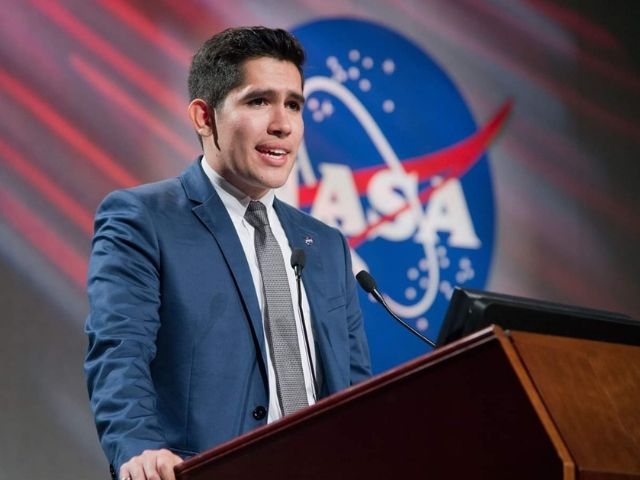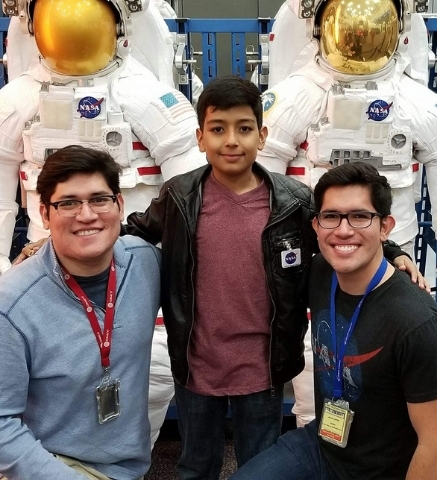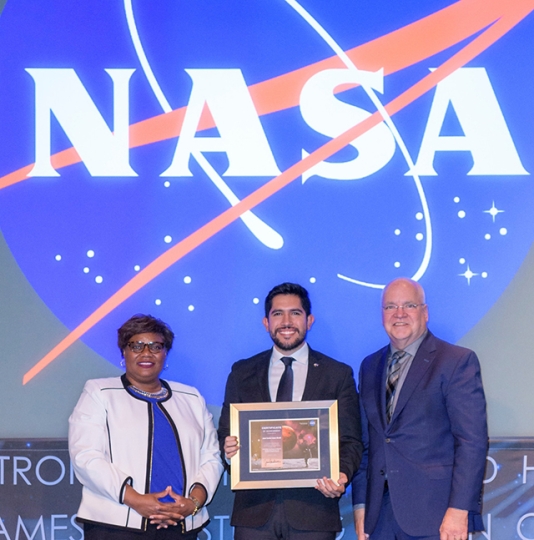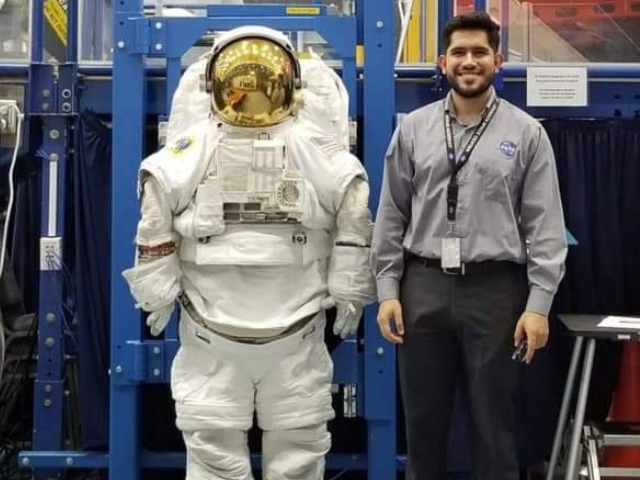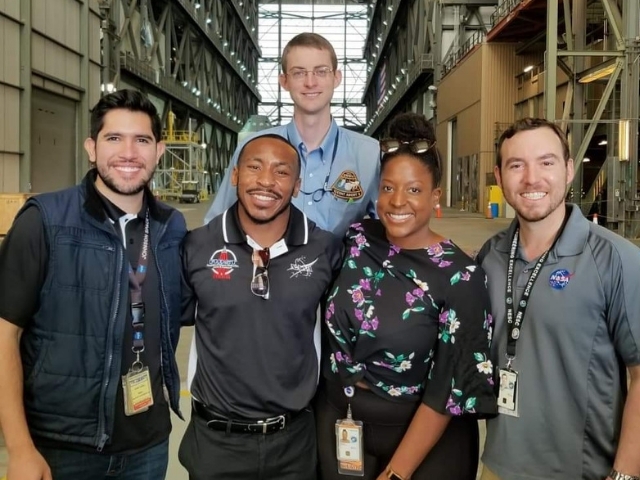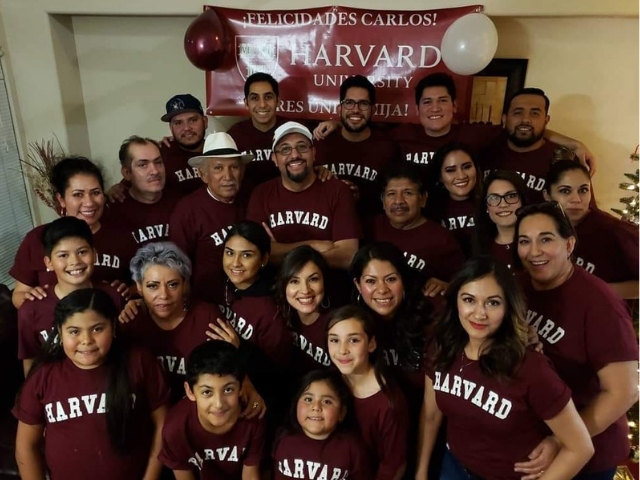News
MS/MBA student Juan Carlos López delivers an address for the Hispanic Heritage Month celebration at the NASA Johnson Space Center in Houston. (Photo provided by Juan Carlos López)
When the first Mexican payload blasts off towards the International Space Station in December, it will be an especially proud day for Juan Carlos López.
The CubeSat developed by the Mexican Space Agency (AEM) will test a constellation of low Earth orbit satellites called GlobalStar, which are designed to streamline communications between Earth and Mars.
López, now a student in the MS/MBA program offered by the John A. Paulson School of Engineering and Applied Sciences and Harvard Business School, served as a technical advisor for the project while working at the Johnson Space Center. President of NASA’s Hispanic Employee Resource Group in Houston, he advocated for the NASA-AEM partnership to connect the space agency to Latin American countries.
“It has been an amazing experience to reconnect to the country I grew up in through NASA,” he said. “I want to use NASA’s vision of exploring space for the benefit of humankind to create opportunities for the people of Mexico.”
López, his younger brother, Erik, and a nephew explore NASA's exhibits. (Photo provided by Juan Carlos López)
Opportunity led López to leave his home in the small, northern Mexican town of Delicias at age 15 and move in with a cousin in El Paso. Born in Garden Grove, Calif., he had U.S. citizenship and emigrated from Mexico because he wanted to learn English and attend college.
López, the oldest of five children, and his 12-year-old brother left their parents behind and moved to south Texas on their own.
“It was hard at the beginning, just trying to understand the language and the culture and learning how to be independent,” he recalled. “Especially during those first few months, my brother would cry at night because he missed our parents, and I would cry with him. But I always tried to stay strong for him and encourage him to keep pushing forward towards pursuing our dreams.”
López buckled down and studied hard in high school, gravitating towards math and science courses. His physics teacher suggested he consider studying engineering and, though he knew little about the field, he majored in mechanical engineering at the University of Texas at El Paso.
Being admitted into college was a dream come true for López, and doors began to open for the ambitious student. Noticing his work ethic and engineering acumen, a professor suggested he apply for a NASA internship program.
López at his graduation from NASA's leadership development program. (Photo provided by Juan Carlos López)
“I didn’t think I was smart enough to go to NASA,” he said. “I was still struggling with the language—this was only two and a half years since I emigrated from Mexico—so I had a lot of insecurities and doubts.”
To his surprise, an acceptance letter from NASA arrived a few weeks later.
The extremely competitive program provided López with a scholarship for his undergraduate education and the opportunity to intern at any of the 10 NASA centers each summer from freshman year to graduation.
“Getting into that internship program was the first sign that the sacrifices that my family and I were making was paying off,” he said. “I remember calling my mom and dad immediately after I got my admission to NASA. My mom started crying on the phone. It was a huge accomplishment.”
During his first internship, López worked at the Johnson Space Center in the acoustics and vibrations lab, conducting assessments on the panels and materials for the Orion spacecraft.
The next summer, he took off for the West Coast and the Jet Propulsion Laboratory, where he studied the dynamics of asteroids and assessed their material properties.
López with an extravehicular activity suit at NASA's spacecraft mockup facility in Houston. (Photo provided by Juan Carlos López)
For his final internship, López returned to Houston where he worked on a modular robotic vehicle, a fully automated electric car that enabled astronauts to easily remove and replace broken parts.
“Everyone I met at NASA was really passionate about the mission of exploring space for the benefit of humankind. That vision is very humbling and inspiring,” he said. “I really enjoyed being able to apply the concepts I was learning in the classroom into real hardware that was going into space.”
After graduation, López was thrilled to accept a full-time position at the Johnson Space Center; he joined the acoustics and vibrations lab where he spent his freshman summer. He developed finite element models to assess how the rocket and payload would shake as they left Earth’s orbit, and ensure those vibrations wouldn’t break the structures or injure the astronauts onboard.
The work was technically intensive, and López was challenged to conduct extremely detailed programming and solve complex differential equations. But he enjoyed working in the structural engineering division due to the huge variety of projects.
One of his favorites was the Bigelow Expandable Activity Module, the first human-rated expandable structure to attach to the International Space Station. López assessed how different inflation levels could affect the frequency of oscillations.
López with friends and colleagues at NASA's vehicle assembly building in Florida. (Photo provided by Juan Carlos López)
“That was very gratifying because of the precedent it had,” he said. “I was also able to see the launch of the vehicle and watch it attach to the space station at Mission Control in Houston, which was really amazing.”
Encountering so many NASA departments impressed upon López the importance of public-private partnerships the space agency is building with SpaceX, Blue Origin, Lockheed Martin, and other firms.
Through those partnerships, NASA plans to delegate low Earth orbit responsibilities to the private sector, so the space agency can devote its resources to long-term missions to the moon and Mars, López explained.
With that future in mind, he switched gears and began working as a commercial portfolio manager at NASA, developing tools to evaluate business proposals from private companies. He also decided to enroll in the MS/MBA program to build stronger business skills.
A surprise family celebration for López' admission into Harvard. (Photo provided by Juan Carlos López)
“When I heard about the MS/MBA program, I thought it was a great opportunity for me to bring these two communities together, to help NASA work with the private sector through my MBA experiences and keep my technical connection and my appreciation of space technology from my M.S. degree,” he said.
He has enjoyed the program’s intense curriculum and fast-paced courses. Being able to share his knowledge of space technology with a diverse cohort of business school students has been fun and rewarding, he said.
López will draw on the lessons he learns from his peers and instructors as he launches the next phase of his career.
“I am really passionate about space and my hope is to go back to the industry and bring the public and private sector together, and also think bigger picture about how we can make space accessible to communities that have been historically excluded or not integrated into the space industry,” he said.
Topics: Academics
Cutting-edge science delivered direct to your inbox.
Join the Harvard SEAS mailing list.
Press Contact
Adam Zewe | 617-496-5878 | azewe@seas.harvard.edu
